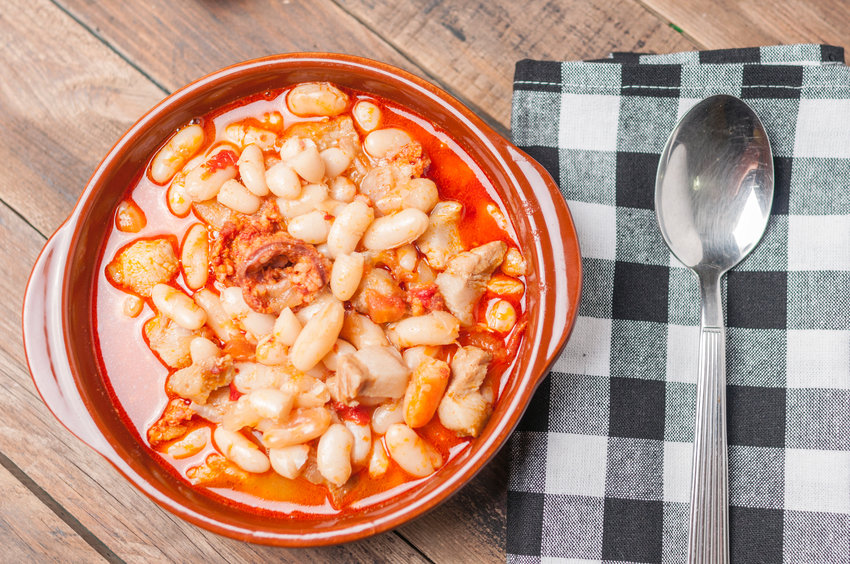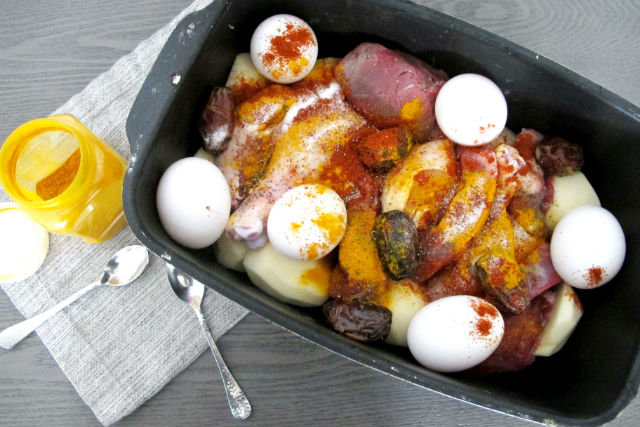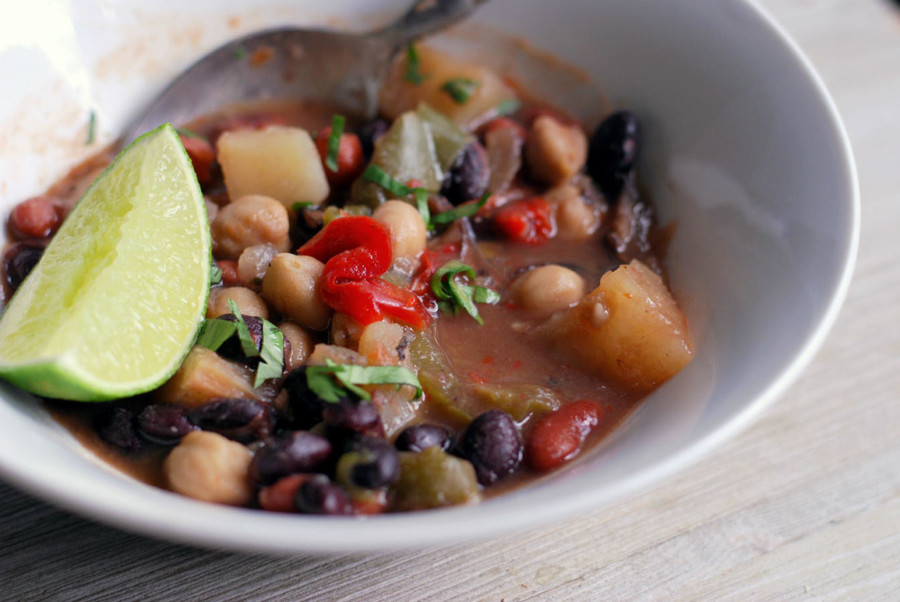To cholent (and why you should be eating it)!
We could all use a little comfort food right now. And while my regular meal of choice when it comes to eating my feelings is a giant piece of layer cake (crowned with a softball scoop of ice cream for good measure), right now I am craving a big pot of cholent.
For cholent, necessity was the bubbe of invention, this unctuous stew coming into being as the ultimate edible workaround to Jewish laws prohibiting cooking on the Sabbath. Traditionally prepared on Friday afternoon and then left to simmer overnight on a hotplate or slow-cooker.
When it comes to what’s in a name, there’s some debate. For years, most have considered cholent to be a compound word coming from the French chaud (“hot) and lent (“slow”) or of chaudes lentes (“hot lentils”). Competing with this definition is also the theory that cholent is Hebraic in origin, coming from she-lan (“that rested [overnight]”) and referring to the practice of Jews keeping familial pots of cholent in their town’s baker’s ovens to cook.
In recent years, however, scholars have offered more nuanced explanations, most notably Max Weinrich, who in his landmark History of the Yiddish Language argues that cholent is derived from the Latin present participle calentem (“that which is hot”) from the Old French chalant, present participle of chalt, from the verb “to warm,” chaloir.
Cholent’s disputed etymological history aptly reflects the multiplicity of its manifestations. If you’ve had one cholent, you definitely haven’t had them all. Cholent can be generally classified by whether it developed via Sephardi or Ashkenazi schools of cookery, though significant variations exist within those groupings.
Known as chamin or hamin among Sephardi Jews, this form of Shabbat stew is made with chicken and often chickpeas. Two distinctive components of Sephardi cholent are whole vegetables (eggplant, green peppers, tomatoes, and zucchini) stuffed with rice and whole eggs cooked in their shells. Chamin is also often spiced with cumin or hot peppers. Such innovations make for a thicker, toothsome dish with levels of earthy heat.
Other iterations of cholent linked to Sephardi culinary tradition include dafina or adafina (from Arabic t’fina, “buried”), which today is most commonly found in North Africa. Dafina frequently contains potatoes and brisket as its respective featured starch and protein as well as saffron or turmeric, which gives it a dusky orange hue.
Ashkenazi cholent is made more regularly with beef and poultry, specifically helzel, chicken neck skin stuffed flour, chicken or goose fat, fried onions and spices or its cured cousin kishke, a sausage encased in bovine intestine (old-school) or edible synthetic tubing (modern). Barley or wheat grains provide carbohydrate richness.
While all cholents involve some combination of chicken, beef, eggs, grains/potatoes, or vegetables, some versions showcase less traditional ingredients like veal, turkey, or even hot dogs. There are also vegetarian versions of cholent chock full of veggies, beans and other plant-based protein. And chefs have even created more upscale interpretation of the beloved comfort food, like Chef Yehuda Sichel’s cholent pot pie.
Ready to dig into a hearty bowl? Here’s a rundown of some recipes you can try:
An Ashkenazi creation
By Shannon Sarna
This recipe is not mine, but it is a close version of the beloved cholent recipe passed down from my husband’s grandmother, Baba Billie Goldberg of blessed memory, to my husband. It is so delicious and I love it, but it wasn’t until our wedding day that I was given the keys to the cholent car: My mother-in-law hand-wrote the recipe on a piece of paper and my husband gave it to me after the chuppah. My official welcome into the Goldberg clan was through a beloved family recipe.
Recipes aren’t always about the food — they can also be about history, how our people adapted in the myriad locations they lived as well as the more personal stories of our loved ones. This cholent recipe is both delicious and rich with memory.
Enjoy these easy directions and let us know how your family likes to make cholent — we know every family has their precious combination of ingredients and spices that make it just right.
Ingredients
1-1/2 lbs fatty stew meat or flanken
4 to 5 marrow bones
1 whole onion, outer layer peeled
2 large or 4 small Yukon gold or russet potatoes, peeled and cut into chunks
3/4 lb. pearl barley (around 2 cups)
1 cup kidney beans
3 to 4 whole garlic cloves, peeled
1/3 cup ketchup
1 Tbsp. paprika
2 tsp. salt
1 tsp. pepper
1 tsp. garlic powder
1 lb. packaged kishke
3 cups water plus additional water
Variation: Can substitute part of the water with vegetable stock, chicken stock or beer.
Directions
1. While prepping your ingredients, cover barley and kidney beans with 3 to 4 cups hot water. Set aside for 20 minutes.
2. Grease the inside of your slow cooker with cooking spray.
3. Add marrow bones, meat and potatoes to pot. Add onion and garlic cloves. Add barley, beans and the water they soaked in.
4. Mix ketchup, paprika and 2-1/2 cups water (can also use beer or stock) and add to pot. Season with salt, pepper and garlic powder. Mix well.
5. Add kishke on top.
6. Set slow cooker to low and cook overnight. Check in the morning and add additional water or stock if it seems dry.
Dafina, Slow-Cooked Moroccan Stew
By Sabrina Ovadia
There is no right or wrong way to make this, and recipes vary from city to city and from family to family. Every Jewish house is distinguished by their dafina and what is included in it. There is even a legend that noble rabbis can sense the peace and holiness of the house from the smell of the dafina.
The most commonly found ingredients are potatoes, sweet potato, chicken, meat, rice, barley, chickpeas and of course, a famous golden brown egg. A lot of recipes call for each item to be placed in individual cooking bags. Everyone adds their personal touch and favorite spices to it; some of the most commonly used spices include paprika, cinnamon, cumin, honey, dates and garlic. I even have a family member who throws in a whole peach, pit and all.
Like the mothers and grandmothers who come before me, I have adapted the recipe handed down to me to my own family’s taste and cook the rice separately. It may not look like much but there are few things that warm the soul quite like a hot dafina on a cold winter day, and I invite you to add your own family’s take on this beloved dish.
Ingredients
2 lbs. flanken meat, on the bone (flanken is short ribs cut across the bones)
4 pieces of chicken, on the bone
12 large red potatoes, peeled
2 cans of chickpeas, rinsed
4 eggs (in the shell)
4 pitted dates
1 Tbsp. salt
1 tsp. pepper
1 tsp. paprika
1 tsp. cumin
1 tsp. turmeric
1 tsp. of honey
1 tsp. cinnamon
3 to 4 garlic cloves
2 Tbsp. of olive oil
Directions
1. Arrange the chickpeas on the bottom of the crockpot. Add the potatoes around the interior walls of the crockpot. Place the meat, chicken, eggs and pitted dates in the center.
2. Add all of the spices and mix very well but gently as to keep each ingredient in it’s place. Pour in enough water to cover everything. The top of the water should hit around 1/2 inches above the ingredients.
3. Set the crockpot at a medium temperature and set to cook for 24 hours. On Shabbat, do not add any water, even boiling, to the crockpot.
Latin-Inspired Vegetarian
By Sandy Leibowitz
Even before slow cookers were invented, Jews all around the world were making their slow-cooked meals out of necessity and in observance of Shabbat. And as it turns out, slow-cooked meals over a low flame are also incredibly delicious.
Here, I decided to embrace my South American roots and make a Latin-inspired, vegetarian version of this traditional dish. Not only do these flavors come together beautifully, but you don’t have to worry about breaking down any tough meat!
I used ripe (yellow-brown) plantains, batatas (sweet potatoes) and yuca along with a variety of beans — which are all starches that come to mind with Latin American cooking. You can certainly use the green plantains; just keep in mind that they take longer to cook. Also, the ripe plantains add a hint of sweetness that works well with the other earthy flavors.
While portobello mushrooms may not be Latin American, I added them for nutrition and a meatier depth of flavor. The squeeze of fresh lime before serving really brightens this dish and brings it to the next level.
Note: The less you cook this dish, the more texture will remain. Cooking longer will decrease the texture but increase the depth of flavor. Substitute parsley for cilantro if you’re not a fan of cilantro, but definitely don’t leave out the fresh lime, it really ties this dish together and makes it taste authentic.
Ingredients
1 portobello mushroom, diced
4 garlic cloves, minced
1 onion, sliced
1/2 green pepper, sliced
1/2 red pepper, sliced
10.5 oz can of black beans, rinsed
10.5 oz can of garbanzo beans (chickpeas) rinsed
10.5 oz can of red kidney beans, rinsed
1/2 yuca, cut in 2-inch pieces (make sure to remove the fibrous stem that runs inside the center. It looks like a vine.)
1/2 batata, cut into medium dice
1 ripe plantain (choose one that is yellowish and has only a few black specks, or choose a green plantain)
1 Tbsp. olive oil
1/4 cup tomato paste
1 tsp. oregano
1/2 tsp. cumin
1 tsp. ground coriander
1/2 tsp. granulated garlic
1/2 tsp. onion powder
1/4 tsp. red pepper flakes (optional)
1 tsp. salt (adjust seasoning as needed)
3 cups of fresh, cold water (it should barely cover your ingredients)
Fresh lime for serving
Cilantro, chopped for garnish
Directions
1. Saute the portobello mushroom in a small saute pan until caramelized well. Add to the bottom of your slow cooker.
2. Layer all the ingredients on top of the mushrooms.
3. Mix the tomato paste, olive oil, spices and water in a bowl and stir well.
4. Pour water and spice mixture over everything inside the slow cooker and combine.
5. Cook on low for 6 to 8 hours.
Texas Cholent No 9
By Ari White, Courtesy joyofkosher.com
Ingredients
Water
3/4 lb. pearled barley, washed
1 can Dr. Pepper
1/2 lb. kishke, cut into 3 slices
1/4 cup teriyaki sauce
1/2 cup ketchup
1/2 cup barbecue sauce
1/2 tsp. chipotle powder or cayenne
1/2 tsp. instant coffee
1 tsp. pepper
1 tsp. salt
1/2 tsp. garam masala
1/2 tsp. cumin
5 cloves garlic, crushed
2 tsp. chili powder
1 tsp. paprika
2 onions
1 tsp. garlic powder
1/2 cup mixed beans soaked in water overnight
4 large potatoes, peeled and chopped
1 large sweet potato
1 lb bullet of salami
1 to 2 marrow bones
1 lb naval pastrami
1 lb 2nd cut brisket or flanken
Directions
1. Place your onions, quartered, marrow bones and brisket in a roasting pan and put under a broiler until both sides have good color, then place in crockpot.
2. Cut your potatoes into manageable pieces, usually 6 to 8 per potato and add to pot as well.
3. Add beans, remaining meats (whole), spices, ketchup, teriyaki, and BBQ sauce into the pot.
4. Pour as evenly as possible your washed pearled barley over everything else.
5. Add can of Dr Pepper.
6. Place the 3 slices of kishke in the center over your pile of barley.
7. Fill to the brim with water and cover with lid.
8. Set mode on high for six hours, then leave in warm mode overnight. Do not touch.
9. Before serving break up the large slabs of meat and allow to cool for about 10 minutes.

 47.0°,
Mostly Cloudy
47.0°,
Mostly Cloudy 













